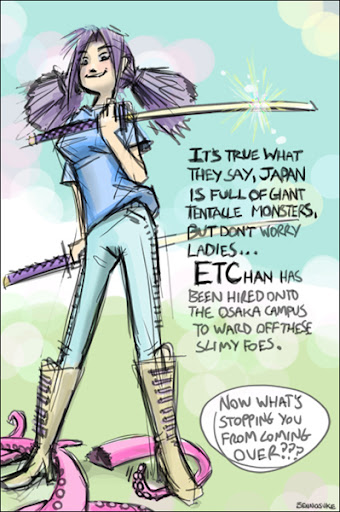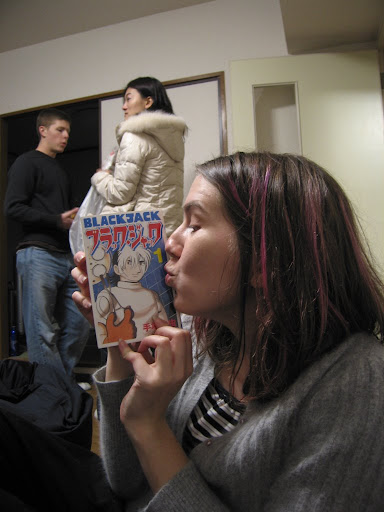- Slide Show of ETC Spaces -
ETC Japan located in Osaka's harbor area of Suminoe may be bigger than you realize. Despite only having a handful of students these past two semesters, ETCJP has the housing capabilities for several teams with as many as 4 individual project rooms and 2 teams could easily share a single space as they equate to the size of roughly 2 ETC Pittsburgh lounges. It's my hope that in the future we can fill such a large space. It's really big!
The ETC provided apartments are quite large as well and have the amenities needed to survive in Japan. Here is a breakdown of some of things (not including objects left by previous students) that are in the apartments:
[Apartments]
Rooms:
- Western Style room
- Tatami (Japanese style) room
- Toilet closet
- Bathroom area with separate bathing space
- Living area with attached smaller dining area
- Kitchen
- Hallway
- Patio
Bathroom:
- Washing Machine
- Shower
- Ofuro (Japanese Bathtub)
Kitchen:
- Pots and Pans
- Silverware
- Chopsticks
- Refrigerator
- Gas Stove
- Tiny Oven in the stove about 6 inches wide, a foot deep and shallow
- Sharp kitchen knife
- Chopping board
Living Area:
- Table
- 4 Chairs
- Tiny, legless (doggy) couch
Sleeping Areas x 2:
- Japanese Futon
- Comforter
- Thin Blanket
- Pillow
General:
- 2 Space Heaters
- 2 Fans
- Lights for each room
Things to Remember to bring:
- Towels
- Deodorant (hard to find stick kind in Japan)
Some of the Apartments may include extra:
- Rice Cooker
- Blinds
- Water Heater or Hotpot
- Drawers, Tables or Shelves
It's also good to bring creature comforts of your own. I for one brought a body pillow and a PS2 with me and so have other students in the past. A couple of us, including myself, brought monitors as well so we can enjoy digital media as well. I also find it nice to appreciate something from time to time from my hometown. Luckily I can buy Heinz ketchup here, which satisfies me. Previous students have had things like hot sauce, Hershey's chocolate and books brought from home. Photos are always nice too.
The office is comfortable and has a lot of space to move around. There is a Wii, a small lounge area (for now), an area with bean bag chairs and fold out furniture to crash on. There's also a refrigerator, microwave oven/toaster, water heater and tea set. If space is available, we'll also set up an individual Skype room for private calls to the states. The ATC, in which the campus is located, and the attached WTC have huge shopping areas with tons of choices for food. There's also several convenience stores inside. If this campus has one serious edge, it's that you really REALLY don't need a car. You can get anywhere in the country by trains and subways and a wide variety of food and snacks are right down the hall. It should also be mentioned that there is a wide range of professional video compositing and sound resources available on the floor above us in the iMedio offices. All in all, it's a good campus with a lot of space and the appropriate software to work. We're in the process of getting a computer hardware upgrade as well.
Come see for yourself!

















